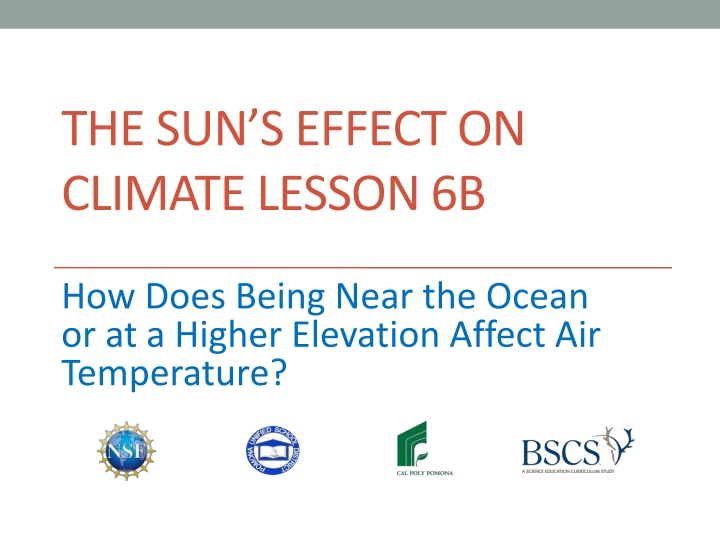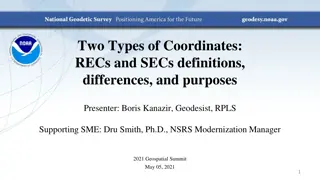
Impact of Ocean Proximity and Elevation on Air Temperature
Explore how the proximity to the ocean and higher elevations influence air temperature patterns through data analysis and elevation profiles. Discover the differences in temperature variations based on geographic features.
Download Presentation

Please find below an Image/Link to download the presentation.
The content on the website is provided AS IS for your information and personal use only. It may not be sold, licensed, or shared on other websites without obtaining consent from the author. If you encounter any issues during the download, it is possible that the publisher has removed the file from their server.
You are allowed to download the files provided on this website for personal or commercial use, subject to the condition that they are used lawfully. All files are the property of their respective owners.
The content on the website is provided AS IS for your information and personal use only. It may not be sold, licensed, or shared on other websites without obtaining consent from the author.
E N D
Presentation Transcript
THE SUNS EFFECT ON CLIMATE LESSON 6B How Does Being Near the Ocean or at a Higher Elevation Affect Air Temperature?
Temperature Patterns of Three Cities How did you complete the following sentences from our last lesson? Make sure to support your reasoning with evidence from the temperature data we collected. 1. The temperature patterns of San Francisco are [consistent/not consistent] with being near a large body of water because _______________. 2. The temperature patterns of Colorado Springs are [consistent/not consistent] with being near a large body of water because _______________. 3. The temperature patterns of St. Louis are [consistent/not consistent] with being near a large body of water because _______________.
Lesson Focus Question How does being near the ocean or at a higher elevation affect air temperature? How is this question different from our last focus question?
Air Temperature and Elevation Today we re going to investigate what happens to air temperatures at higher elevations. What does elevation mean? Why might higher elevations have different temperature patterns than lower elevations?
What Is an Elevation Profile? Elevation (in Feet) Miles
How Does Elevation Affect Air Temperatures? 1. Read the overview on page 1 of handout 6.1 (Uneven Heating). Then read the Collecting Data instructions for part 2 (Investigating Elevation) on page 3. 2. Read the story about the expedition to Mount Everest in handout 6.3 (Climb to Cold). 3. Each time the team in the story takes an elevation and temperature reading (at the stop signs), record this data on your data table (in handout 6.1). (Not all locations will have temperature data.) 4. Make sure to look for temperature patterns related to changes in elevation!
How Does Elevation Affect Air Temperatures? 1. After completing the story, read the Graphing Data section on handout 6.1 (Uneven Heating). 2. Then create an elevation profile. On the graph, plot the elevation data for each location from the data table (handout 6.1) and write the matching temperature data next to each data point. Then draw a line connecting the data points and shade the area below the line. 3. Search for patterns in the elevation profile. Then pair up and discuss the questions on pages 4 and 5 of your handout. Be prepared to share!
How Does Elevation Affect Air Temperatures? 1. What temperature patterns did you observe as the climbers traveled to the summit of Mount Everest? 2. Why might the climbers have had to wear oxygen masks as they approached the summit? 3. How do you think air density relates to air temperature? 4. Based on the elevation and temperature data you collected, how would you explain why the air temperature gets colder at higher elevations?
Making Connections Key science idea: As elevation increases, air temperatures decrease. How do you think this science idea relates to our line-graph data for the three cities from lesson 5? Which city s temperature data gives us a clue about its elevation? Why do you think so?
Explaining Temperature Differences How might our soil and water investigation from the previous lesson and today s elevation investigation help us explain why the average monthly temperatures are different in three US cities located at the same latitude?
Explaining Temperature Differences Evidence: Explain: Think about ... The city line- graph data The soil and water temperatures Data from Climb to Cold Why are the average monthly temperatures different in three cities located at the same latitude? Be prepared to share your ideas!
Todays Focus Question How does being near the ocean or at a higher elevation affect air temperature? Why do you think the average monthly temperatures are different in three cities located at the same latitude? Keep the focus question in mind as you share your ideas. Make sure to include evidence from our investigations.
Lets Summarize! Factors that affect temperature patterns and regional climates: 1. Solar radiation hits Earth s curved surface at different angles based on latitude. The angle of sunlight is more direct closer to the equator and less direct closer to the poles. Places that receive more direct sunlight are warmer than places that receive less direct sunlight.
Lets Summarize! 2. The consistent tilt of Earth on its axis changes where sunlight strikes the surface at different times of the year. When the Northern Hemisphere tilts toward the Sun, it receives more direct sunlight and experiences summer. When the Northern Hemisphere tilts away from the Sun, it receives less direct sunlight and experiences winter. Seasons in the Southern Hemisphere are opposite from seasons in the Northern Hemisphere.
Lets Summarize! 3. Even though latitude has the biggest influence on climate, other factors influence regional temperature patterns, such as elevation or being near large bodies of water. Water absorbs and releases heat more slowly, so places near the ocean have more steady temperatures during the year. Land heats and cools more rapidly, so places that aren t near large bodies of water experience bigger temperature variations in the summer and winter. Elevation also affects temperatures, and higher elevations are typically cooler than lower elevations.
Next Time In the next lesson, we ll see if we can answer some challenging questions about how the factors we ve been talking about affect temperatures and climates around the world.





















